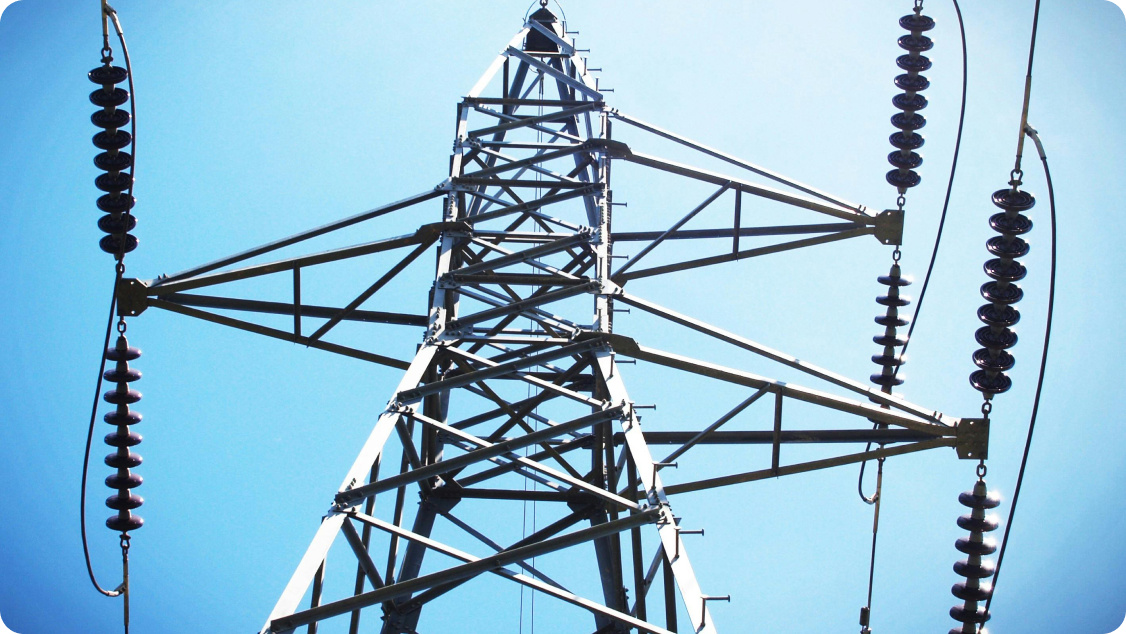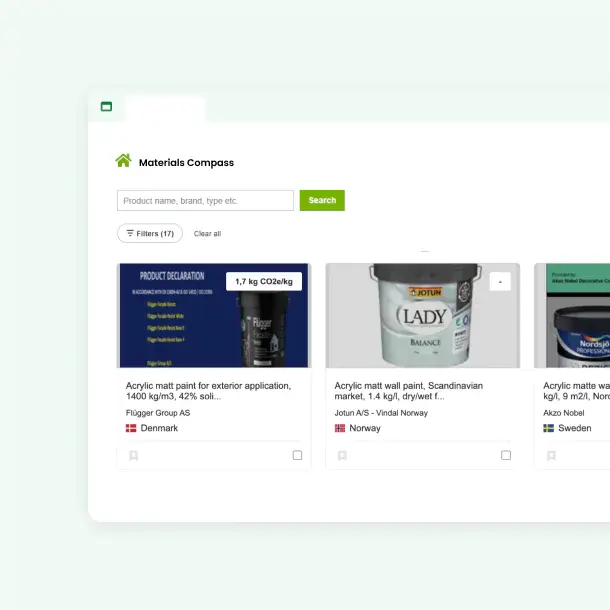
One Click LCA provides comprehensive energy data for life-cycle assessments. The rigorous four-step process sources data from reputable providers like the IEA and eGRID to ensure accuracy and reliability, supporting sustainable construction by meeting global standards and certification requirements.
What is energy data?
One Click LCA provides comprehensive energy data for life-cycle assessment (LCA), including environmental impact data for electricity mixes, grids, district heating, and residual electricity at the country level.
Why produce energy data?
At One Click LCA, we recognize the need for high-quality energy data to complete your project assessments. Our goal is to offer reliable, consistent, and current energy data, simplifying your LCA process.
How we produce energy data
One Click LCA source energy mix compositions (the quantity of every fuel or energy source used in forming the respective energy mix ) from reputable public data providers like the International Energy Agency (IEA) and eGRID. We use life-cycle inventory (LCI) data to model the underlying processes and flows.One Click LCA's energy data modeling employs advanced software and undergoes strict quality assurance, including automated benchmarking against the world’s largest construction LCA database.
One Click LCA’s four-step process
When producing energy data at One Click LCA, we follow a rigorous four-step process to ensure quality, accuracy, and transparency.
1. Sourcing upstream and quantitative data
One Click LCA obtains the energy mix composition from reputable and publicly available data providers. The acquired data is most often available on a national level, but in some cases, more granular data is available, e.g. for individual states or grids.
The International Energy Agency (IEA) is a key source due to its global reach. Other key data sources include the Emissions & Generation Resource Integrated Database (eGRID) by the United States Environmental Protection Agency (EPA) and national governments, e.g. in the Nordic countries. The IEA provides statistical energy data from most countries worldwide on an annual basis. Additionally, the IEA requires all countries to report data in a specific, uniform format, ensuring the data is high-quality, reliable, consistent, and frequently updated.
At One Click LCA, we use the IEA as our main source for obtaining quantitative data for the manufacturing of electricity and district heating. The IEA provides data for a large portion of the world's countries and updates it annually. The IEA's comprehensive information allows us to produce accurate energy models without relying on specific countries' energy statistics, which often lack sufficient granularity and detail for energy modeling purposes. Consequently, One Click LCA relies on this uniform, singular data source.
Below is a screenshot of the IEA's website energy statistics tables, One Click LCA's primary source of data.
.png?width=831&height=591&name=Group%204317%20(46).png)
Figure 1: Source — IEA website
2. Modeling with energy creation software
The energy modeling process begins with selecting the appropriate fuels or energy sources from a specially modified version of the upstream life-cycle inventories. Then, energy mixes are calculated using One Click LCA’s internal Energy LCA profile tool and finalized for customer use.
One Click LCA uses generally available life-cycle inventories for underlying processes and flows with a few customizations. The first addition is the voltage transformation burden added to the original dataset. Transmission burdens are obtained from the IEA, World Bank, and their DataBank World Development Indicators.
The second addition is direct emissions (smokestack emissions), which are essential for producing energy (electricity or district heating) but are not part of the standard EN15804 +A1/+A2 data arrays. This data is sourced separately from the emission factors database EFDB 2020, based on IPCC 2006 Guidelines.
Import and export values are highlighted in Figure 1 to show that these values are not detailed enough to specify the countries from which the energy is imported. Without this information, it is not possible to reliably include imported/exported values in the model. Therefore, One Click LCA calculates energy (electricity and district heat) based solely on internal production.
Calculations ensure that the final result in One Click LCA energy models includes the full array of emission factors for the impact indicators covered in standards EN15804 +A1 and +A2, as well as other specific certification schemes and PCRs such as the International EPD System, INIES France, and TRACI applicable for the US.
3. Review and internal verification
The LCA data expert responsible for modeling the specific energy data is supported by a team of experienced peers through an internal quality assurance process to ensure model accuracy, rigidity, and integrity.
First, the model and its resulting environmental impacts are reviewed as a stand-alone case to verify calculation logic and data completeness. The expertise of the LCA data team at One Click LCA is crucial in maintaining high quality and reliability during this manual review and verification phase.
Second, the resulting environmental impacts are benchmarked against other energy data, both from the same country and source data from other calendar years and countries.
4. Publishing and availability
Once the review process is complete and data quality is confirmed, the energy data is published and becomes available in the One Click LCA database. This data can now be accessed in our software for both design & construction and manufacturing.
In most cases, One Click LCA energy data includes environmental impact indicators required by all regulations, standards, and Green Building Councils (GBC) worldwide. It is available in most of our tools globally, subject to specific rules for the use of energy data in each tool.
One Click LCA energy data typically includes environmental impacts for standards such as EN 15804+A2, EN 15804+A1, TRACI, ISO 14040, ISO 14044, and ISO 21930. It also includes additional indicators as required by specific Product Category Rules (PCR) and EPD programs globally, including the International EPD System, INIES France, Boverket Sweden, and EPD Norge.
The published energy data description provides information about the dataset and source data, along with transparent explanations of any assumptions or exclusions made during data creation.
Can you request One Click LCA to add specific energy data for your LCA projects?
Yes, you can contact Customer Success at One Click LCA to request the integration of new energy data needed for your LCA projects.
Please note that One Click LCA will evaluate and prioritize such integration based on the needs of its global customer base. You can also order the energy data integration via your support services subscription to ensure timely delivery. This is a paid service, and our team is happy to assist you with details and options.
Please also bear in mind that the expert LCA data team will need to assess whether it is possible to fulfill your request, as not all requests can be completed. As explained in this article, energy data integration is constrained by the exact nature of the datasets available.
If you have specific data you wish to use, you can also add it directly to your company account via the user interface as Private data. This feature is available to all Expert license users, and instructions on how to create Private data can be found on the One Click LCA Help Centre.
Why is One Click LCA energy data based on electricity mix source data that does not represent the current year?
One Click LCA gathers much of the source data for its energy data from the International Energy Agency (IEA) due to its global reach. Other key data sources include the Emissions & Generation Resource Integrated Database (eGRID) by the United States Environmental Protection Agency (EPA) and national governments e.g. in the Nordic countries.
The IEA handles statistical energy data from countries worldwide. It requires data to be reported in a specific, uniform format from all countries, so it takes time for national institutions and then the IEA to compile and finalize all the data. One Click LCA typically waits until the end of each calendar year for the IEA to complete the data for a new year before updating energy data for all countries globally in bulk.
For example, energy mix data for the calendar year 2022 is collected by the IEA during 2023. It gets published towards the end of the year and is then integrated by One Click LCA, so it is available at the start of 2024.
To a lesser extent, One Click LCA is similarly dependent on the update cycles of other data sources and seeks to update such data once per calendar year.
Why doesn’t One Click LCA use energy data as reported by some national authorities directly? Why are the environmental impacts of One Click LCA energy data different from the data reported by national authorities in your country?
In some cases, we do, such as the Emissions & Generation Resource Integrated Database (eGRID) by the United States Environmental Protection Agency (EPA) and national governments in the Nordic countries. When we do not, the simple explanation is that the reported data format, calculation method, and assumptions are most likely different. In some cases, the source data cannot be verified.
Many national authorities do not report data in the detail required to produce energy datasets with all environmental impacts necessary for LCA. For example, national authorities in many countries publish energy data only with Global Warming Potential (GWP) in kgCO2e/kWh of the particular energy mix. While we can integrate this data, it has limited usability as data with GWP only is not accepted by many tools, regulations, certifications, and standards.
Additionally, when reporting energy data directly instead of via the IEA, many national authorities do not report data in the same uniform format, making it difficult or impossible to use it as a basis for creating reliable, transparent, and comparable energy datasets. In other words, the data reported by national authorities directly does not match or is not comparable to the data they report via the IEA, even though it applies to the same calendar year.
- The reported data is GWP only, lacking other required impact indicators.
- The reported data is in kgCO2/kWh (kilograms of carbon dioxide per kilowatt-hour) whereas it should be in kgCO2e/kWh (kilograms of carbon dioxide equivalent per kilowatt-hour), as required by most regulations and standards.
- Direct combustion impacts of fossil fuels are excluded from the calculations.
- Renewable energy is included in the data with no associated environmental impacts.
- Imported and exported energy is included in the calculations.
Find, compare & choose low-carbon construction materials
The Materials Compass from One Click LCA is designed to help construction professionals cut carbon in their projects & achieve sustainability goals by finding, comparing, and choosing the most sustainable building materials.

Carbon Experts Newsletter
Industry news & insights — straight to your inbox
Want to learn more?
Vesna Medic • Aug 06 2024
Jani Tierala • Aug 02 2024
Asha Ramachandran • Feb 13 2024
Roberta Belanova • Sep 04 2024
